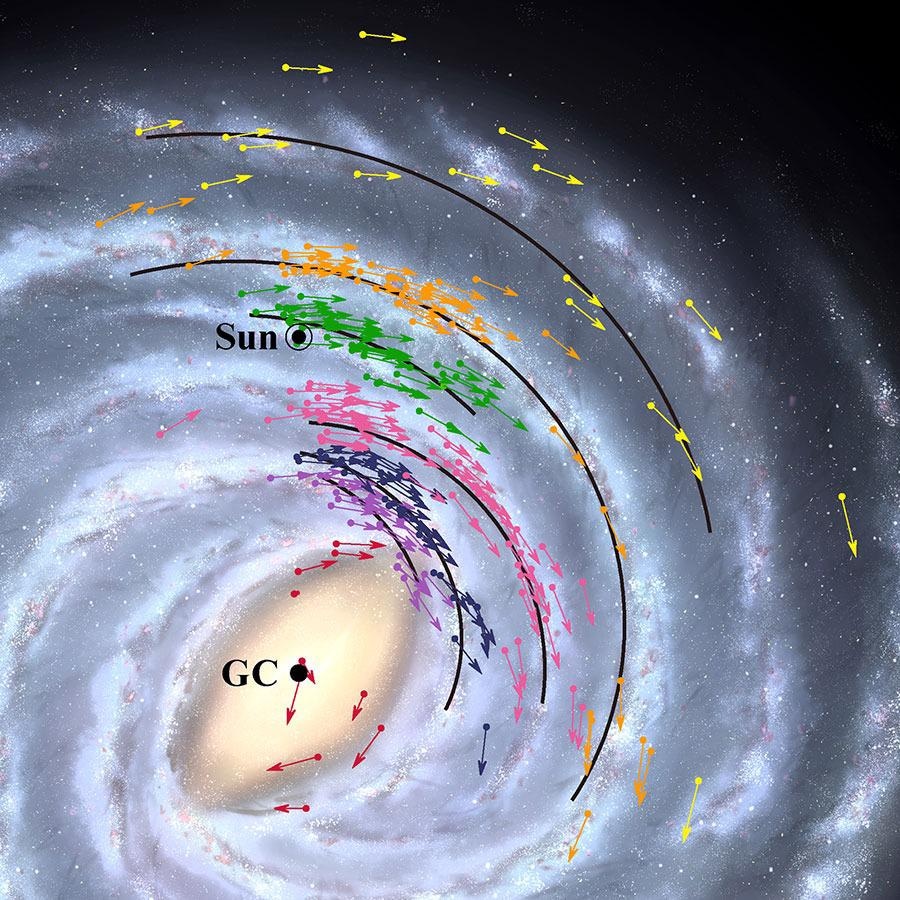Nov 27 2020
A new study shows that Earth is traveling 7 km/second faster and nearly 2000 light-years closer to the supermassive black hole at the center of the Milky Way Galaxy. However, this does not necessarily mean that Earth is sinking toward the black hole.
 Position and velocity map of the Milky Way Galaxy. Arrows show position and velocity data for the 224 objects used to model the Milky Way Galaxy. The solid black lines show the positions of the Galaxy’s spiral arms. The colors indicate groups of objects belonging to the same arm. The background is a simulation image. Image Credit: NAOJ.
Position and velocity map of the Milky Way Galaxy. Arrows show position and velocity data for the 224 objects used to model the Milky Way Galaxy. The solid black lines show the positions of the Galaxy’s spiral arms. The colors indicate groups of objects belonging to the same arm. The background is a simulation image. Image Credit: NAOJ.
Rather, the variations are the outcomes of an improved model of the Milky Way Galaxy developed based on fresh observation data, which includes a catalog of objects observed for over 15 years by the Japanese radio astronomy project VERA (VLBI Exploration of Radio Astrometry, where “VLBI” stands for Very Long Baseline Interferometry).
Started in the year 2000 to map three-dimensional spatial and velocity structures in the Milky Way, VERA involves using a technique called interferometry to integrate data from radio telescopes distributed across the Japanese archipelago to realize the same resolution as a 2300 km diameter telescope can achieve.
The 10 micro-arcseconds measurement precision realized using this resolution is sufficiently sharp in theory to resolve a United States penny positioned on the surface of the Moon.
Since Earth is situated within the Milky Way Galaxy, it is not feasible to step back and observe how the Galaxy looks when viewed from the outside. Astrometry, or the precise measurement of the motions and positions of objects, is an essential tool to gain insights into the overall structure of the Galaxy and Earth’s place in it. The First VERA Astrometry Catalog was published this year and includes data related to 99 objects.
Astronomers developed a position and velocity map based on recent observations by other groups and the VERA Astrometry Catalog. They used this map to calculate the center of the Galaxy, the point around which everything revolves.
The map indicates that the center of the Galaxy, and the supermassive black hole which dwells there, is situated 25,800 light-years from Earth. This distance is nearer compared to the official value of 27,700 light-years denoted by the International Astronomical Union in 1985.
The velocity component of the map suggests that Earth is moving at a speed of 227 km/second while simultaneously orbiting around the Galactic Center. This speed is higher than the official value of 220 km/second.
VERA now aims to view many more objects, specifically those closer to the central supermassive black hole, to better describe the structure and motion of the Galaxy.
To this end, VERA will take part in EAVN (East Asian VLBI Network), which includes radio telescopes located in Japan, South Korea, and China. EAVN can realize much higher accuracy by increasing the number of telescopes and the maximum separation between telescopes.
“The First VERA Astrometry Catalog” authored by VERA collaboration et al., was published in Publications of the Astronomical Society of Japan in August 2020.